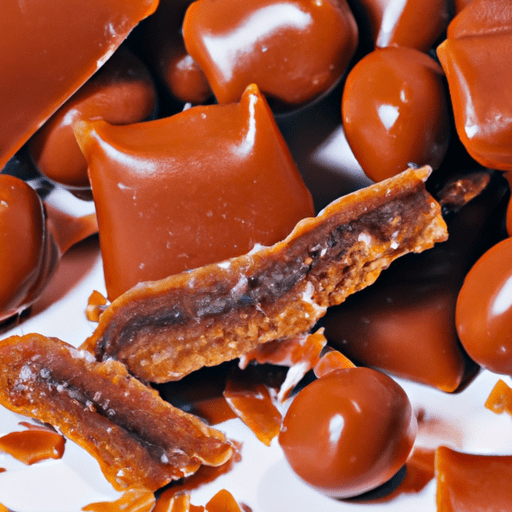The Tempting Toffee Bar: A Sweet Delight
If there’s one treat that never fails to make your taste buds dance with joy, it’s the beloved toffee bar. This irresistible confection is a true indulgence, offering a perfect harmony of sweetness and crunch. In this blog post, we’ll take a closer look at this delectable treat, exploring its taste, common uses in cooking, nutritional value, and fascinating history that makes it a classic choice for any dessert table.
A Symphony of Flavor and Texture
Toffee bars are renowned for their rich, buttery flavor and delightful crunchy texture. These delectable treats consist of a rich butter and sugar base, cooked to perfection until it reaches a deep golden hue. The toffee is then poured over a layer of smooth chocolate, allowing it to set and create a firm, yet melt-in-your-mouth texture.
Versatility in the Kitchen
Toffee bars are highly versatile and can be used in a variety of ways in the culinary world. They can be simply enjoyed on their own as a satisfying snack, or used as a key ingredient in various dessert recipes. The sweet, caramel-like flavor of toffee pairs beautifully with ice cream, making it an ideal topping for sundaes. Crushed toffee bars can also be incorporated into cookie dough, adding a delightful burst of flavor and a pleasant crunch.
The Journey Through Nutritional Value
While indulging in a toffee bar may not be the healthiest choice, it’s worth exploring its nutritional value. Toffee bars are primarily made of sugar and butter, so they are undeniably high in calories. However, they also contain trace amounts of calcium, iron, and phosphorus due to the dairy content. It’s important to enjoy these sweet treats in moderation, savoring them as an occasional treat rather than a daily indulgence.
A Brief History and Fun Facts
Toffee bars have a fascinating history that can be traced back to the early 19th century in England. The term “toffee” is derived from the word “taffy,” which refers to a type of chewy candy. Over time, toffee evolved into a hard, crunchy treat akin to the bars we enjoy today. Interestingly, toffee has been associated with various holidays and celebrations, such as Christmas in the United Kingdom. It’s not uncommon to find beautifully wrapped toffee bars nestled in holiday gift baskets or stockings.
In Conclusion
Toffee bars are a timeless treat that never fails to captivate our palates with their sweet and buttery taste. Whether enjoyed on their own or as part of a luscious dessert creation, they bring smiles to faces and a touch of indulgence to any occasion. In moderation, these tempting treats are a delightful addition to your culinary repertoire. So go ahead, indulge in a toffee bar and experience the sheer pleasure it offers!
Note: Please consume sweets in moderation as part of a balanced diet.
Toffee bar
Origin: The exact origin of toffee bars is unclear, but they are believed to have originated in England. Toffee itself has been enjoyed in England since the 19th century, and the toffee bar likely developed as a way to make portable and shareable toffee treats.
Common uses: Toffee bars are popular sweet treats that are often enjoyed as snacks or desserts. They can be eaten on their own, crumbled and used as a topping for ice cream or other desserts, or incorporated into various recipes such as cookies or cakes.
Nutritional benefits: Toffee bars are predominantly made from sugar, butter, and often include nuts or chocolate. While they provide energy due to their sugar content, they are generally considered a high-calorie indulgence and should be enjoyed in moderation.
Unique properties: Toffee bars are known for their rich, buttery, and caramel-like flavor. They have a firm texture that can vary from slightly chewy to hard and brittle, depending on the recipe and cooking process. The combination of sweet, buttery, and crunchy textures makes them appealing to many people.
Historical significance: Toffee bars, like toffee itself, have a long history of being enjoyed as a sweet treat. Toffee’s popularity increased in the 19th century when sugar became more affordable and accessible. Over time, recipes for toffee bars have evolved to include various flavors and ingredients, allowing for different variations and adaptations. Today, toffee bars continue to be a beloved confectionery item enjoyed by people of all ages.




Use the share button below if you liked it.
It makes me smile, when I see it.